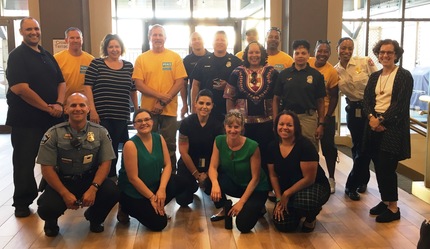|
The Metropolitan Economic
Development Association (MEDA) recently named Jashan Eison the 2016 Entrepreneur of the Year.
The award is given to minority entrepreneurs who demonstrate industry
leadership, business success, economic impact and community involvement.
Eison, a Milwaukee native and graduate of the University of
Wisconsin-Stout, moved from California
to the Twin Cities more than 10 years ago. Since that time he has been working at H&B Elevators climbing from project
manager to CEO.
With the help of MEDA, Eison acquired H&B Elevators in
2013 and moved the headquarters from south Minneapolis to North Minneapolis. He
now oversees 50 employees.
H&B Elevators has manufactured elevators for buildings
all over the world. Local projects include the U.S. Bank Stadium and the newly
renovated State Capital.
See
the whole story.

PEACE mentors from MPD, 911, MFD, Hennepin County,
and the City's
Attorney's Office
PEACE (Pathways to Emergency and Academy Career Experiences)
program administered by Minneapolis Employment and Training, is a collaborative initiative designed to promote access and entry into Justice and Emergency Services (JES) career pathways for low-income, court-involved, or at-risk Minneapolis youth ages 16 to 21. Students learn about JES careers through mentoring by a career professional, mini-academies, and a paid summer internship in the field.
To date, 39 students and 26 mentors are enrolled in the program. Internships are being offered by the Minneapolis Police Department (MPD), 911, the Minneapolis Fire Department (MFD), Hennepin County, and the City Attorney’s Office (CAO). PEACE students can participate in career academies developed by partners at MPD, MFD, 911, CAO, Hennepin County, and the FBI.
On June 15, PEACE held its first monthly mentor event that included games and 1:1 time with mentors and mentees. PEACE staff received great feedback about the matches being good fits.
ShaVonda Allen, PEACE program manager, is excited about the development and growth of PEACE and looks forward to the coming months.
D. Craig Taylor, who has led the city of Minneapolis’
Community Planning and Economic Development department since August 2014, is
leaving the agency in August to pursue new opportunities. Taylor’s last
official day with CPED is August 25, but he will be using the remainder of his
vacation throughout August.
Mayor Betsy Hodges has nominated David Frank, currently the
agency’s Director of Economic Development and Policy, to serve as CPED’s
interim executive director. The nomination must be approved by the executive
committee of the Minneapolis City Council. Frank is expected to begin serving
as the interim executive director on August 2. Frank joined CPED, which
currently has 241 employees, in 2011.
Read more.
Twin Cities builders and contractors
are in the midst of one of their busiest years. But a shortage of skilled
workers means that new projects are costing more and taking longer to complete.
As of May, there were more than
125,000 construction workers in Minnesota, the most for that month since 2006.
And the latest tally of construction job openings was the highest in at least a
decade.
The industry is getting more
creative in promoting construction careers. This summer a consortium of industry groups will launch Project Build Minnesota, a marketing campaign aimed at “making construction sexy
again,” said David Siegel, executive director of the Builders Association of
the Twin Cities.
A collective of
labor unions launched its own PR campaign dubbed Elevate Minnesota to promote union construction jobs this year.
A third group called the Twin Cities
Construction Sector Initiative, which includes the Associated General Contractors, the Minnesota
Building Trades Council, educational institutions
and other stakeholders, is taking a higher-level look at workforce needs. That
group hopes to roll out a multiyear plan by end of the summer.
Learn
more.
In this high technology
era, four years and a bachelor's degree is hardly the only smart path
to take. Only 22 percent of jobs in Minnesota require a bachelor's or above but
many believe a four-year college degree is optimal for everyone, and that any
other path to a career is “for dummies.”
However, young people who choose a
two-year associate’s degree, an apprenticeship, or an occupational certificate
can land in-demand, well-paying jobs, avoid crippling debt and
look forward to a secure future.
The focus on four-year colleges is
failing many young people and is placing society’s future prosperity in jeopardy.
Students and their parents can find information at DEED as they make
postsecondary plans.
“What to Know Before You Owe,” available
online — lays out a great initial decision-making
strategy.
The online “Graduate Employment
Outcomes” tool shows how many
Minnesota graduates are finding jobs from a broad range of majors and at what
wages.
“Occupations
in Demand” includes information about careers that
don’t require postsecondary training.
Read the whole article here.
Each year, thousands of people leave
foreign cities, towns, villages, and refugee camps to make a new life in Minnesota.
Immigrants’ stories are as varied as
the corners of the world they come from — Somalia, Mexico, Laos, India, Kenya,
Russia, the Philippines, and Ecuador, to name a few. But they generally share
one thing: a search for opportunity. Often, that means economic opportunity.
What those opportunities look like,
though, depends on where immigrants are coming from. That’s made clear by U.S.
Census data that looks at sectors of employment for people born outside of the
U.S.
Learn
more.
Minnesota is America’s
Third-Best State for Business in 2017, according to a new report released
recently by CNBC. Minnesota moved into the third spot this year, after placing
fourth in 2016 and coming in first as America’s Top State for Business in 2015.
CNBC’s annual study scores
all 50 states on 66 measures of competitiveness.
|